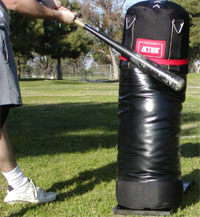Heavy Practice Bag

The heavy practice bag is an excellent tool for developing good swing mechanics. It can help a batter end lunging problems and it aids in teaching a batter how to develop early bat speed. If you are not familiar in practicing with a heavy bag, be sure to check out the article provided in the "More Information" link below.
Misconception of Practicing with the Heavy Bag
The following will clarify the use of the heavy bag as a practice tool and clear up some of the confusion some coaches have. The goal of practicing with a heavy bag is not to drive the bat through the bag or cause the bag to move or swing and this should not be taught. In fact, practicing with the heavy bag has wrongly been equated to that of hitting deflated basketballs or similar objects. The principles behind practicing heavy bag drills are very different than mechanics developed from hitting deflated basketballs. The problem stems from a misunderstanding of what occurs at contact and the follow-thorough portion of the swing.
The concepts surrounding the "follow-through" phase of the swing have long been misunderstood. In the past, coaches were taught to hit the ball hard by teaching batters to continue driving through the ball after contact. Thus, it is understandable why many coaches would adopt drills that would require the batter to continue "pushing" the bat through the follow-through phase, such as hitting deflated balls.
For example, to propel a deflated basketball forward requires the basketball to remain in contact with the bat for an extended period of time. The bat would stay in contact with the deflated ball for eight or more inches after the initial contact. Therefore, swinging at deflated basketballs would definitely require the batter to continue applying energy to the bat after making contact, but this is not true for hitting a baseball or softball.
Studies have shown that the baseball is only in contact with the bat for approximately 1/2000 of a second. During this split second, the bat moves forward less than 3/4 of an inch (while in contact with the ball). Therefore, any energy applied to the bat after contact has no effect on the ball's flight. In fact, it is simply wasted energy. A batter with good transfer mechanics will deplete all energy for generating bat speed prior to or by contact.
On the other hand, the weaker hitter will develop considerable bat speed after the bat has passed through the optimum contact zone. In this case, the bat-head is dragging as it enters the contact zone and in order to accelerate the bat-head to maximum velocity, the average hitter continues to apply forces to the bat well after passing the optimum contact point, much like hitting a deflate ball. This is also the reason why weaker hitters have little power to the opposite field, yet many of their better-hit balls are pulled foul.
The Purpose of Practicing with a Heavy Bag
The purpose of using a heavy bag is to absorb the bat's energy at the contact point. After just a little practice, the batter will learn that exerting force to the bat after contact is pointless. This will help train the batter to develop transfer mechanics (and timing) that will expend all energy prior to or by contact. The batter should deplete all rotational and torque energies as the bat-head reaches maximum velocity and contact. Stated another way, all energy will have been sucked out of the "system" as maximum bat speed is reached.
Therefore, after all of the body's energy has been transferred into bat speed, the body and limbs are at rest. Hip and shoulder rotation is complete - the arms are relaxed, and there is no energies being applied to the bat. The bat's energy has been expended into the heavy bag, all momentum has ceased, and the muscles are relaxed and motionless. Thus, you now have what amounts to "a frozen video frame" of the batter's mechanics at contact.
This is not what you will observe with less efficient transfer mechanics. Improper initiation of the swing (thrusting the top-hand forward) quickly places the batter behind the power curve and he/she is left with trying to develop bat speed after the bat reaches contact. Striking the heavy bag with tense arms that are still in the driving forward mode, can cause discomfort to the hands and wrist, and should be avoided. Therefore, take it easy until the batter's transfer mechanics improve so that the batter is not applying force after contact.
As you can see, the mechanics developed while swinging at deflated basketballs are quite different than those used with heavy bag drills. A batter's progress will be slowed when hitting an object, which requires the batter to reserve energy for a powerful follow-through. In a good swing, the bat's momentum will pull the body and limbs through the coast-out phase of the swing, not from reserved energy. A heavy bag, used correctly, can assist you in learning rotational mechanics and generating early bat speed.
| 
![]()